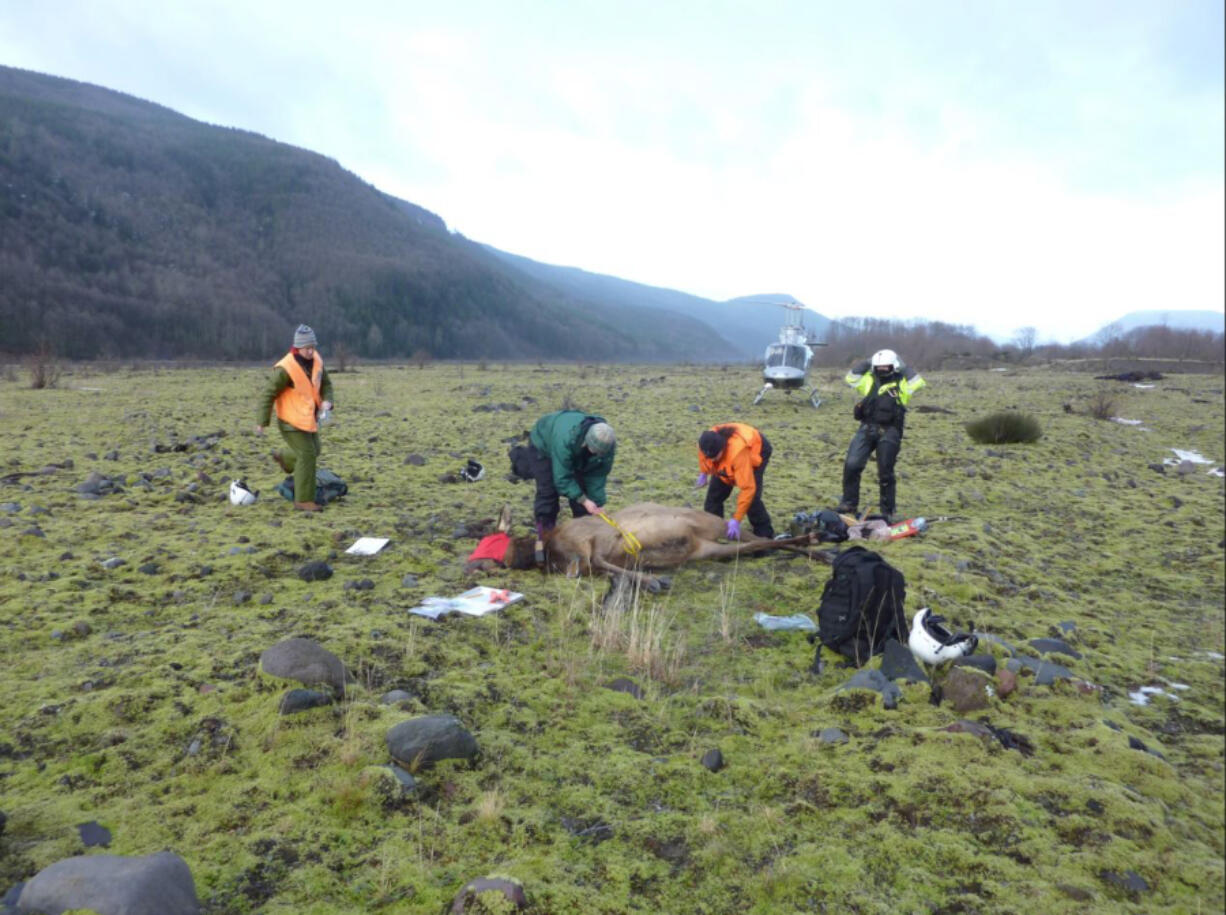Scientists that have been researching Treponema-Associated Hoof Disease (TAHD) in elk have not found any magic pill to eliminate it, although there are some promising signs emerging from the data.
It is probable that the disease is here to stay, but there may be changes coming to the landscape that could mitigate some of the negative effects of the disease.
Southwest Washington is ground zero for TAHD, for it is here that it first appeared within the Mount St. Helens elk herd, one of 10 major elk herds in the state. It came into public awareness when hunters and others became alarmed at the prevalence of limping elk within the herd, and hunters began to take animals with tell-tale signs of the disease.
Elk infected with hoof disease display ulcers on their feet, and overgrown, broken, or sloughed hooves. The affected animals are eventually debilitated and experience higher mortality than healthy elk.
By 2017 the situation had become so dire that the Washington legislature passed Senate Bill 5474 directing the state to provide funds for the Washington State University’s College of Veterinary Medicine to conduct research on the disease.
The disease has had a devastating effect on the Mount St. Helens herd, and has spread to other Washington herds and four other states. Still, this herd has been the hardest hit of any elk herd anywhere.
Brendan Oates, an Ungulate specialist for WDFW, said the herd was already stressed when the disease hit.
“We had the Mount St. Helens eruption in 1980, and that opened up a lot of area, and elk really thrive in those open areas,” said Oates. “There was a lot of grasses, sedges, and shrubs that they like to forage on.”
With so much food available, the herd exploded in numbers.
“But when those canopies closed in the late 90’s, there wasn’t enough food for all those animals.”
Adult elk began dying of hunger during the winter months, and the entire herd struggled to stay healthy. That is when TAHD arrived on the scene.
Dr. Margaret Wild leads the elk hoof disease research team at WSU. She reports that while there is definitely a correlation between the stressed-out herd and the rapid spread of the disease, it is not a certainty that the poor condition of the animals was the cause of the outbreak.
“Figuring out mortality is challenging,” said Wild. “There is a correlation here, but causality is tough to (prove).”
Dr. Wild’s captive elk research has shown that elk can develop TAHD without being exposed to herbicides, which was something that many local wildlife enthusiasts pointed to as a possible cause in the early days of the outbreak.
“We don’t have any data to support the negative impacts of herbicides on elk,” Wild said. “Still, herbicide applications have not been ruled out as something that could affect elk health.”
Her research has shown that the treponema bacteria seems to prosper in the wetter soils of western Washington. Affected herds in drier areas east of the Cascades have not developed the same level of prevalence within the herds as the elk in wet environments.
The wolf effect
For the Mount St. Helens herd and other herds in western Washington, there may be some benefit from the arrival of a new apex predator: wolves. Both Wild and Oates believe that the eventual arrival of wolves in the western part of the state could be beneficial to the infected herds.
“Wolves are always looking for the easiest animal they can take,” Oates said. “Elk with hoof disease are much easier.”
While having wolves on the landscape is controversial, they could very well help slow the spread and prevalence of the disease. Wild’s research in the past with Chronic Wasting Disease in deer has produced some insights into the way wolves can effect a herd’s health.
“We’ve actually done modeling work a decade or more ago looking at how wolves could help manage CWD,” she said. “In the modeling that we did, it was the only thing that decreased the prevalence of CWD.”
Oates agrees that wolves could help drive prevalence down.
“We know that the more elk there are on the landscape with the disease the more likely it’s going to get transmitted to healthy elk,” he said, “and with the wolves taking out these animals you are reducing the transmission rate.”
However, the arrival of wolves will undoubtedly spark controversy, and many of these predators will be killed by people angry over their arrival. Oates said that in areas where wolf packs have been established, unreported killing of wolves often takes place.
For scientists, though, watching the colonization of new areas by wolves can give them insights into how wolves maintain the health of the elk populations they prey upon, as well as possibly push diseases such as TAHD into a role that is not so dominating.
When asked what she found most exciting about their research, Wild professed enthusiasm for their work of pathogen discovery. They are doing sequencing of DNA and bacteria from the hooves of infected animals, and identifying new types of Treponema.
“The pathogen discovery has been really exciting,” Wild said. “I would suspect that there is some way these bacteria have adapted to elk.”
WDFW Hoof Disease Harvest Incentive Program
Oates would like to see more participation in the WDFW Hoof Disease Harvest Incentive Program. This program rewards hunters that harvest an infected elk and donate the hooves for research.
Those hunters are put into a special program that gives them a much higher chance at drawing some quality elk tags. So far, participation has been below expectations.
Oates reports that those hooves, as well as the information the hunters include, is extremely helpful in the agencies understanding of the prevalence of the disease within the herds. The hooves are also very important for the research of Wild’s team.
Check out the incentive program here: WDFW Elk Hoof Disease Harvest Incentive Program




